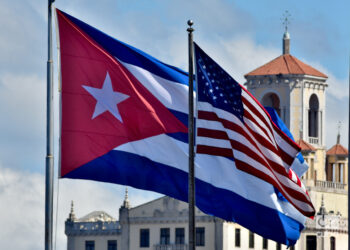The creation by the U.S. government of a task force to expand access to the Internet in Cuba is a response to a “failed policy,” according to an article published by the daily Granma.
The Communist Party of Cuba newspaper affirms that like previous “subversive” programs organized by the U.S. authorities, the new measure will not be able to change the country’s internal order.
“If President Donald Trump’s administration aims to use the new technologies to impose changes in Cuba’s internal organization, he chose very old paths that have already demonstrated in the past their inoperativeness and ineffectiveness,” says the Granma article.
For the newspaper, the announcement made this Tuesday by the Department of State “opens the doors to a return to a failed Cold War policy” that both countries had tried to overcome after the reestablishment of bilateral relations during the Obama administration.
The creation of this new task force shows that “there is no lack of liquidity” in a “government that is paralyzed and has no funds” when it’s a question of “financing subversive projects against Cuba,” according to the Cuban publication.
The force, comprising persons in and outside the U.S. government, seeks the “promotion of the free and non-regulated flow of information in Cuba,” according to what the Department of State reported in a short press release.
This decision is a response to President Trump’s memorandum on the island last June, and is made at a time in which bilateral ties have cooled due to the turnabout in the Cuba policy promoted by the current administration and the alleged sonic attacks.
Free access to the Internet is a pending subject for the Cuban authorities which since three years ago have started to slowly offer this service, first in public areas (Wi-Fi zones), later at home through the so-called Nauta Hogar and this year they plan to do it from cell phones.
The rollback
In Granma’s opinion, the creation of the U.S. task force is “the continuation of the far-fetched and badly adviced speech” in which Trump announced in Miami his government’s new position toward the island, which rolls back part of what had been advanced by his predecessor, Barack Obama, and Cuban President Raúl Castro.
“The field chosen for the new aggression, the Internet, clearly shows Washington’s real objectives when it demands ‘free access’ to the worldwide web in the countries opposed to it, while on its territory it maintains a mega tracing system” of its citizens, said Cuba’s principal daily.
For the publication, the ability to organize the personnel for these new forces “contrasts” with the reduction of Washington’s diplomatic personnel in Havana due to the alleged sonic attacks, which paralyzed the issuing of visas for Cubans on the island for lack of personnel.
“Trump’s new plans don’t take Cuba by surprise, since the country has more than half a century of experience in confronting all kinds of aggression programs,” Granma affirms.
The article recalls previous projects like ZunZuneo, Piramideo and Commotion, social and message media promoted by the U.S. government especially directed at the island’s young people, on the fringes of the Cuban authorities.
“If the aim of the Trump administration is to exclusively guarantee Cubans’ access to the Internet, it could well eliminate the blockade’s restrictions that prevent the purchase of cutting-edge technology…. Perhaps it would be cheaper than a ‘task force’ that is, from the start, condemned to failure,” the text concludes.
Cuban official data reveal that 2017 was a year of expansion of the access to the Internet on the island, with 40 percent of Cubans connected to the Internet, 37 percent more than in 2010.
According to the Global Overview report, last year Cuba became the country with the greatest growth in digital connectivity and presence on the social media, with more than 2.7 million new users and a 365 percent increase in relation to 2016.
However, the connection prices are still very high for the average Cuban wage, which doesn’t reach 30 dollars.
In Cuba there are a daily 250,000 connections in the more than 500 Wi-Fi public zones.
EFE / OnCuba










